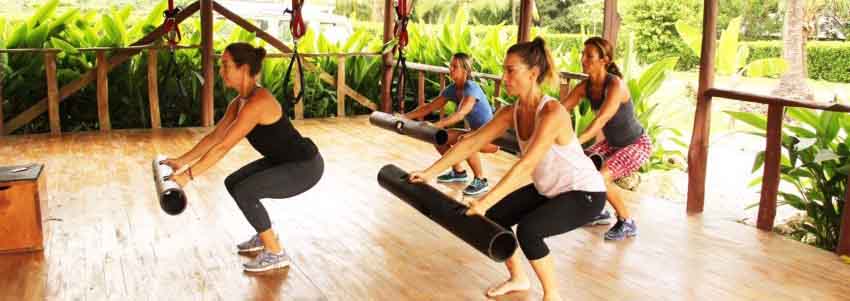5 tips from Gisele’s trainer for a workout you’ll actually enjoy
Genetics might prevent us from achieving a body like Gisele Bundchen’s,
but we can at least work out like her
Celebrity workout guru Jill Payne, who has trained Bundchen, hosted a workshop at BSC Studio last month as part of an eight-city tour to promote her new mind-body brand, Spiritual Athlete. And while we can report that there’s no magic push-up to get supermodel fit, Payne might help you achieve Bundchen’s blissful attitude.
Spiritual Athlete is a hybrid motivation and fitness program that’s concerned with reducing stress and promoting positive thinking over counting reps and sets. Payne’s philosophy is that if you’re mentally positive, you’ll naturally have more energy, inspiring you to be more physically active. In addition to deep breathing exercises and acupressure work, Payne encouraged workshop attendees to envision themselves “moving like a 10” in a “beautiful state” both before and during the workout.
“All beautiful states require physical energy,” she said. “If you want to thrive in anything – relationships, a career – you have to ask yourself how you can get to a place physically where you’re able to live in that beautiful state.”
Here are some of Payne’s basic exercise principles so you can find joy in your own workout—or at least a little less struggle.
Breathe
Payne got her start as a yoga instructor – a practice that relies heavily on breathing through sequences of poses – and she encourages linking movement to breath in any workout. “Breath is directly related to energy,” she said. According to Payne, taking deep breaths throughout a workout keeps your nervous system calm and contributes to an overall sense of well-being. “Most of us breathe into our chests, which doesn’t calm your body,” she said.
The key to deeper breath is activating your diaphragm – a muscle below your lungs – so you can breathe into your belly. Before your workout, lie in a comfortable position on the floor and hook your fingers under your ribcage like you’re trying to lift it up. Start at your sternum and work your way down toward your hip, massaging the muscles under your ribs as you go. This should help loosen your muscles and allow deeper, more restorative breath.
Smile
It might seem too easy, but Payne believes smiling throughout even the toughest sweat session is the simplest and fastest way to get into a positive mindset about your workout. “Before you do anything, your question should be, ‘Am I at a 10? What do I need to do to get there?’” she said. “Smiling is the easiest place to start.”
Target overlooked muscles
Payne has a whole-body approach to fitness, but she puts her focus on the diaphragm, the psoas (the deepest muscles in your core that run from your spine to your legs), and the glutes – three muscle groups that aren’t often at the core of training. According to Payne, these three muscle groups are at the center of your body’s most basic needs for success in fitness and in general: breathing and moving. Payne believes a workout that doesn’t address these muscles leads to compensated movement patterns that can result in injury.
To strengthen the psoas and glutes, Payne suggests practicing a yoga posture called bridge: Lie flat on your back with your knees bent and your feet flat on the floor, hip’s width apart. Stretch your arms alongside your body toward your feet; your fingertips should be able to graze your heels. If you have a yoga block, place it between your knees; if you don’t have access to one, focus on keeping your knees hip’s width apart throughout the pose. Without putting strain on your neck, lift your hips toward the ceiling. Pay attention to engaging your core and your glutes as you lift — the movement shouldn’t be driven by your legs. Hold the pose for several breaths, then release back to the floor. Repeat this movement several times, breathing deeply into your belly to activate your diaphragm.
Talk to yourself
“Our lives are reflections of the stories we tell ourselves,” Payne said. “You want to be on the same team as the voice in your head.” She insists that positive internal dialogue is key for the kind of motivation that leads to lasting change.
When you’re feeling frustrated with your fitness progress, Payne discourages comparing yourself with others who might be more physically fit; instead, she suggests repeating phrases like, “Everything I need is right here,” and, “Move like a 10.” Positive thinking helps keep stress levels low and energy up, she said, ultimately contributing to a stronger workout.
Strike a pose
If you find yourself struggling to keep momentum during challenging reps or circuits, Payne suggests a power pose: Try a superhero stance with your feet hip-width apart, your hands on your hips and your chest lifted, or raise your hands above your head like you’re a rock star thanking a crowd. Moves like this “make you feel like you’ve already won,” she said, and contribute to an overall sense of positivity. “Exercise can be used to empower, rather than make you feel bad,” Payne said. After all, her number one piece of advice for sustained physical empowerment? Find an activity you love and make it fun.
By Lauren Friel
Originally appeared on Boston.com March 4, 2017




